Apr 27, 2023
100 Japanese words-10
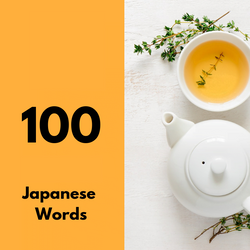
100 Japanese words-10
100 Japanese words-10

Basic Japanese Grammar Guide Part II – Particles (wa, ga, o, ni, de)
Basic Japanese Grammar Guide Part II – Particles (wa, ga, o, ni, de)
Basic Japanese Grammar: Using Particles
Creating longer sentences in Japanese typically involves inserting different kinds of information in between the subject and predicate. To do this requires an understanding of basic Japanese grammar, which is why grammatical units known as “particles” help simplify this process.
Japanese particles are similar to English prepositions, words like “in” and “at”. As shown below, while English uses prepositions, which precede the noun, clause, or phrase they modify, Japanese uses postpositions, which come after the clause or phrase.
Kare no heya de bangohan o tabemashita. We had dinner in his room.
彼の部屋で晩御飯を食べました.
Maiasa roku-ji ni okimasu. I wake up at six o’clock every morning.
毎朝六時に起きます.
Although particles themselves do not carry any meaning, they provide an important role in sentence formation. For example, English does not use particles and thus relies on word order within a sentence. In other words, changing the order of words in an English sentence can result in a completely different meaning.
I gave her my dog. ≠ I gave my dog her.
However, what is crucial in a Japanese sentence is not word order, but the units of information made up of a particle and the noun, clause, or phrase it modifies.
Watashi wa kanojo ni inu o ageta. = Watashi wa inu o kanojo ni ageta. (I gave her my dog.)
私は彼女に犬を上げた. = 私は犬を彼女にあげた.
Even if the words of a sentence appear in a different order, as long as the particles remain the same, the meaning of the sentence does not change.
There are a few different types of particles, so let’s take a look at some of them and their functions below.
Wa ー は
[Subject]
Watashi wa Tai-jin desu. I am a Thai Person.
私はタイ人です.
Kore wa gohyaku-en desu. This costs 500 yen.
これは五百円です.
[Topic]
Kino wa izakaya ni ikimashita. Yesterday I went to an izakaya.
昨日は居酒屋に行きました.
Natsu-yasumi wa nani o shimashita ka. What did you do over the summer break?
夏休みは何をしましたか?
[Comparisons]
Sushi wa suki desu ga, sashimi wa kirai desu. I like sushi, but I don’t like sashimi.
寿司は好きですが刺身は嫌いです.
o (wo) – を
[Object]
Shimbun o yomimasu. I read newspapers.
新聞を読みます.
Kohi o nomimasu. I drink coffee
コーヒーを飲みます.
ni – に
[Object]
Tomodachi ni aimasu. I’m going to see my friend.
友達に会います.
Chichi ni nekutai o agemasu. I’m going to give my dad a necktie.
父にネクタイを上げます.
[Destination]
Chugoku ni ikimasu. I’m going to China.
中国に行きます.
Nihon ni kimasu. I’m coming to Japan.
日本にきます.
Uchi ni kaerimasu. I’m going back home.
うちに帰ります.
*The particle “e” is used to indicate a general direciton as well as a destination, and is interchangeable with “ni”.
[Time]
Shichi-ji ni okimasu. I get up at seven o’clock.
七時に起きます.
Juichi-ji ni nemasu. I go to bed at eleven o’clock.
十一時に寝ます.
San-ji ni modorimasu. I’ll come back at three o’clock.
三時に戻ります.
[Location]
Ototo no heya ni terebi ga arimasu. There’s a TV in my little brother’s room.
弟の部屋にテレビがあります.
de – で
[Place of action]
Resutoran de bangohan o tabemasu. I eat dinner at restaurants.
レストランで晩御飯を食べます.
[Means]
Basu de ikimasu. I’ll go by bus.
バスで行きます.
[Selection]
– Waiter: Would you like bread or rice? –
Pan de onegaishimasu. Bread please. (I’d like a bread.)
パンでお願いします.
If you find this post helpful, check out other Basic
Japanese Basic Grammar Guide Part III – Japanese Particles (No, To, Mo, Kara, Made, Ga) の、と、から、まで、が
Japanese Basic Grammar Guide Part III – Japanese Particles (No, To, Mo, Kara, Made, Ga) の、と、から、まで、が
5. no – の
の Can be used to express possession of an object – the following sentences show that it is an easy sentence pattern to learn and remember.
[Posession]
watashi no kuruma – My car.
私の車
tomodachi no hon – My friend’s book.
友達の本
の Can also be used to express affiliation to an organization in Japanese such as the following sentences.
[Affiliation]
A-sha no shain – An employee of Company A
A 社の社員
A-Daigaku no gakusei – A Student of University A
A-大学の学生
Further to this – の can be used to describe an attribute of a person or object’s identity. Just like in English – we have the ability to do this by saying that someone is a “Japanese Teacher” – we can use の in the same way.
[Attribute (Type/Nature)]
Nihongo no sensei – Japanese Teacher
日本語の先生
ichigo no shabetto – Strawberry Sherbert
いちごのシャーベット
Additionally, の can be used for Apposition / when there is a relationship between two people
[Apposition]
Tomodachi no Yoko-San – My friend yoko
友達のよこ
otto no Tomu – My Husband Tom
夫のトム
There is one more use for the の particle – which is using it as a pronoun. We have the same pattern in english – we can say “the X one”.
[Pronoun]
akai no – The red one.
赤いの
atsui no – The hot one.
暑いの
6. to – と
The to – と particle in Japanese can be used to signify partnership in action – or to form pairs – here are several examples of the Japanese particle in use.
[A partner in an action]
Tomodachi to eiga o mimashita. – I saw a movie with my friend.
友達と映画を見ました。
Eri-san to kekkon shimashita. – I married Eri-san.
エリさんと結婚しました。
Shacho to hanashimasu. – I will speak with the CEO/Boss.
社長と話します。
[Parallel phrases] pan to tomago – Bread and Eggs
パンと卵。
7. mo – も
The mo も particle is used to signify similarity and agreement in Japanese. Additionally it can be used to add emphasis to a particular statement in Japanese.
[Sameness / Agreement]
Kore mo onegaishimasu – I’ll have this too please.
これもお願いします.
Watashi mo eiga ga suki desu. – I also like movies.
私も映画が好きです.
[Emphasis]
Wain o go-hon mo nomimashita. – I drank five bottles of wine!
ワインを五本も飲みました.
8. kara – から
Kara is used in Japanese to signify the origin of duration or origin of motion.
[Origin of duration or motion] Uchi kara gakko made sanjuppun kakarimasu. – It takes thirty minutes to get from our house to the school.
うちから学校まで三十分かかります.
9. made – まで
Just like with Kara – Made (まで) is used to signify the end point of a duration or motion.
[Termination of duration or motion]
Ku-ji kara juichi-ji made benkyo shimasu. – I study from nine until eleven o’clock.
九時から十一時まで勉強します。
10. Ga – が
The Ga (が) Particle can be used for several cases. Although the particle “ga” essentially follows the subject of a sentence, it sometimes provides a function similar to other particles. Because this can make “ga” confusing to use, try to remember the five patterns below.
[The subject of an interrogative sentence that uses an interrogative word]
Dare ga kimasu ka – Who is coming?
誰が来ますか?
Itsu ga ii desu ka. – When would be a good time?
いつがいいですか ?
[The subject of a sentence denoting possession or location]
Uchi ni pasokon ga arimasu. – We have a computer at our home.
うちにパソコンがあります。
Toire ni neko ga imasu. – There is a cat in the restroom.
トイレに猫がいます。
[The subject of an embedded clause modifying a noun phrase] Kore wa Betoben ga tsukutta kyoku desu. – This is a piece of music that is composed by Beethoven.
これはベートーヴェンが作った曲です。
[Objects] (1) suki, kirai, jouzu, heta (Like, Dislike, Be Good At, Be Bad At)
好き、嫌い、上手、下手
Sakka ga suki desu. I like Soccer.
サッカが好きです。
(2) wakaru, dekiru, mieru, kikoeru (understand, can do, can see, can hear)
わかる、できる、見える、聞こえる
Koko kara Fuji-san o miru koto ga dekimasu. – It is possible to see Mount Fuji from here.
ここから富士山を見ることができます。
(3) hoshii, shitai (want/need, want to do)
欲しい、したい
Atarashii terebi ga hoshii desu. – I want a new TV.
新いテレビが欲しいです。
Nihongo ga benkyou shitai desu. – I want to study Japanese.
日本語が勉強したいです。
[An aspect of part of the subject.] Imoto wa kami ga nagai. – My younger sister has long hair.
妹うは髪が長い。
Nihon wa hanzai ga sukunai.
日本は犯罪が少ない。

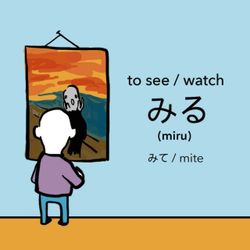
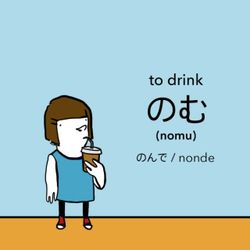
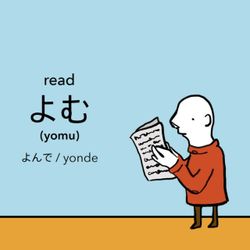

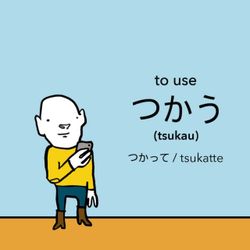
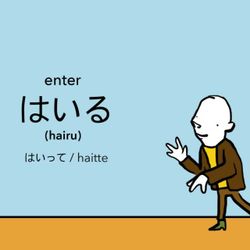
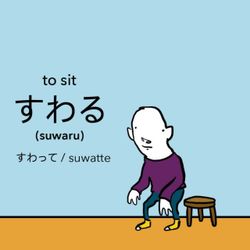
Japanese Basic Grammar Guide Part IV – Verbs
Japanese Basic Grammar Guide Part IV – Verbs
Introduction
Japanese Verbs are typically split into 3 groups, Ru-Verbs, U-Verbs as well as Irregular Verbs. Each of these tend to be conjugated differently so we’ll be discussing about that as well in a while!
Although Japanese verbs assume a variety of conjugations depending on tense and their function within a sentence, the 3 most basic verb forms are the Dictionary Form, Masu-Form and the Te-Form.
8 Basic Verbs
8 Basic Verbs
Dictionary Form
Also known as the plain form, the Dictionary Form frequently appears in casual conversation and is also used in different grammatical expression. Verbs in its Dictionary Form can also fall under 3 different categories: Ru-Verbs, U-Verbs and Irregular Verbs.
Below are a few of the more common verbs in its Dictionary Form which you may eventually come by.
Ru-Verbs
たべる (Taberu) – To Eat
Basic Verb: To Eat
To Eat
みる(Miru) – To See/Look/Watch
Basic Verb: To See/ To Watch
To See/ To Watch
Note: Ru-Verbs typically contains an “I” or “E” sound on the previous alphabet before ending with a Ru.
E.g. Tab(e)ru and M(i)ru
U-Verbs
のむ (Nomu) – To Drink
Basic Verb: To Drink
To Drink
よむ (Yomu) – To Read
Basic Verb: To Read
To Read
かく (Kaku) – To Write
Basic Verb: To Write
To Write
つかう (Tsukau) – To Use
Basic Verb: To Use
To Use
はいる (Hairu) – To Enter
Basic Verb: To Enter
To Enter
すわる (Suwaru) – To Sit
Basic Verb: To Sit
To Sit
Note: U-Verbs typically end with a “U” at the end.
E.g. Nom(u), Kak(u), Tsuka(u), Hair(u), Suwar(u)
Irregular Verbs
コピーする(Kopii Suru) – To Copy
Note: Irregular Verbs typically end with “Suru” which also means “To Do”.
ます (Masu) Form
As for the ます (Masu) Form, it is typically used in conversations when you are trying to be polite.
Ru-Verbs
たべる (Taberu) becomes たべます (Tabemasu)
みる(Miru) becomes みます (Mimasu)
Note: General rule is to remove “Ru” and replace it with “Masu”.
U-Verbs
のむ (Nomu) becomes のみます (Nomimasu)
かく (Kaku) becomes かきます(Kakimasu)
つかう (Tsukau) becomes つかいます (Tsukaimasu)
はいる (Hairu) becomes はいります (Hairimasu)
///
すわる (Suwaru) becomes すわります (Suwarimasu)
Note: General rule is to change the last alphabet in its Dictionary Form to a similar one ending with an “I” sound before attaching “Masu”.
E.g. Ka(ku) becomes Ka(ki) + Masu, No(mu) becomes No(mi) + Masu.
Irregular Verbs
コピーする (Kopii Suru) becomes コピーします (Kopii Shimasu)
Note: General rule is to conjugate “Suru” into “Shimasu”.
て (Te) Form
The て (Te) Form, on the other hand, can usually be conveniently used to create a wide variety of grammatical expressions.
Ru-Verbs
たべる (Taberu) becomes たべて (Tabete)
みる(Miru) becomes みて (Mite)
Note: General rule is to remove “Ru” and replace it with “Te”.
U-Verbs
のむ (Nomu) becomes のんで (Nonde)
かく (Kaku) becomes かいて (Kaite)
つかう (Tsukau) becomes つかって(Tsukatte)
はいる (Hairu) becomesはいって (Haitte)
すわる (Suwaru) becomes すわって (Suwatte)
Note: This is where it starts confusing. Depending on what the U-Verb ends with, its て (Te) Form can actually vary. Nevertheless, the general rule is still to replace the last alphabet in its Dictionary Form based on the following:
む/ぶ/ぬ (Mu/Bu/Nu) becomes んで (nde)
く (Ku) becomes いて (ite)
ぐ (Gu) becomes いで (ide)
つ/う/る (Tsu/U/Ru) becomes って (tte)
Irregular Verbs
コピーする(Kopii Suru) becomesコピーして (Kopii Shite)
Note: General rule is to conjugate “Suru” into “Shite”.
By undefined
14 notes ・ 31 views
Japanese
Beginner